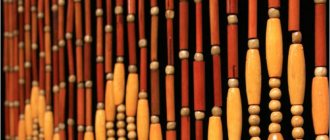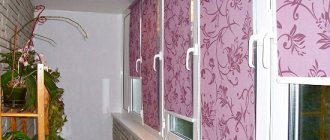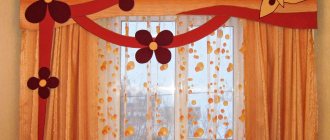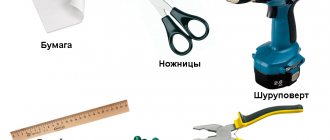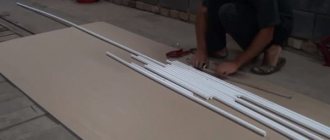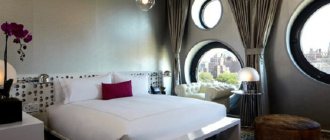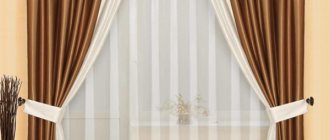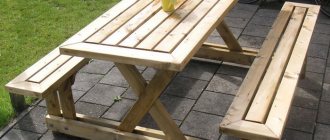How to sew curtains with your own hands.
2. Calculation of the width of the drawstring and the height of the frill. Using a tape measure, measure the diameter of the rod or rod and add an additional 3 cm (B). Decide how tall the frill will be and multiply that number by 2 (C).
3. Calculation of fabric consumption. To determine the overall cut length of the curtain (D), add together A, B and C and add 11.5 cm for seam allowance. By multiplying D by the number of panels used, you calculate the total amount of fabric consumed.
4. Cut and sew curtains. Cut the required number of panels according to the total cutting length D. Sew the curtains, making a hem 10 cm high.
5. Marking the drawstring and frill. Turn the top raw edge over to the wrong side 1.5 cm and press. From the fold line, use pins or tailor's chalk to mark the width of the drawstring (1/2 B) and the height of the frill (1/2 C). Fold the fabric along the frill line and iron.
What are cafe curtains?
A variant of straight curtains, which are fixed not above the opening, but in the middle, is called cafe curtains. They only cover the bottom of the window. This style is suitable for most rustic styles and is appropriate in a naive shabby chic design or in a Mediterranean interior. To make such curtains, natural fabrics with a chintz pattern (small pattern of flowers, polka dots) or with contrasting checks of different sizes are often used.
To work you will need:
- tailor's meter;
- chalk or pencil;
- textile;
- sewing machine;
- scissors.
Take measurements of width (with a gathering factor of at least 1.5) and length, add side and bottom allowances. For the drawstring (in the upper part of the curtain with your own hands), you need to calculate the diameter of the curtain rod. Multiply this value by 3 and add another 2-3 cm to the result for a loose fit. Take into account the hem allowance (1-1.5 cm). If you want to make a drawstring with a scallop, then add the double height of this decorative detail to the result of all previous calculations. Add the final value to the length measurement with allowance for hem at the bottom.
Read also: All about curtains in the Provence style
We cut and sew curtains with our own hands in the following order:
- Mark a rectangle on the fabric according to the calculated measurements of width with allowance and length, taking into account the drawstring and comb (if needed). Cut 1 or 2 panels of cafe curtains.
- Fold and stitch the side seams.
- From the top cut, put down the drawstring allowance with or without a comb. Draw a straight line to mark the stitching line for the hem. Iron the allowance calculated for the hem on the fabric (1-1.5 cm from the cut).
- Divide the distance from the ironed fold to the straight line marked earlier by 2, draw a line and bend the fabric along it. The fold can be ironed if the curtain has a scallop.
- Align the ironed cut with the straight line, which marks the location of the hem stitch (see point 3). Make a stitch along the edge of the hem at a distance of 1-2 mm from the fold.
- If the drawstring is with a ridge, then from the place where the folded edge is sewn to the panel, set aside an amount equal to the diameter of the cornice multiplied by 3, and an allowance for a loose fit. Draw a new line from the wrong side of the panel. On top there will be a free part of the fabric folded in half - the comb.
- Hang the curtains on the curtain rod, align the lower edges of the adjacent curtains. Fold and pin. Remove from the bar, iron and stitch along the hem.
The curtain rod must be inserted into the drawstring. For ease of movement of the fabric along the cornice and bullae, an allowance for a loose fit is needed. The comb will create a frill that sticks up above the drawstring. It is not recommended to make a comb more than 5 cm, especially on thin fabrics: under its own weight it can bend and lose its decorative effect.
Both a simple straight curtain and a cafe style can be complemented with fringe or ruffles along the bottom edge and side cuts. A ruffle (frill) is made from the same or contrasting strip of fabric, the length of which is 2-2.5 times the length of the side where it needs to be sewn. The decor forms beautiful folds along the edge of the product.
Instead of a drawstring, decorative loops made of contrasting fabric can be sewn on the upper edge of both styles. They are cut separately, cutting out double-width strips. They are stitched along the edge, turned onto the face, and smoothed out. The sections are folded inwards by 0.5 cm and a stitch is made 1-2 mm from the edge. The loop can be attached using a large bright button or simply sewn on. When calculating the length of strips for decorative hinges, you need to take into account the diameter of the cornice rod. Eyelets can also be used as decoration and hanging.
Read also: How to decorate a kitchen window with curtains in the Art Nouveau style
Drawstring curtains: types, design and selection tips
Initially, curtains were a way to preserve and retain heat in the house and had an exclusively practical purpose. Over time, they began to be decorated with additional elements and used as the main decorative accent of the room.
Currently, drawstring curtains are gaining popularity again, which ideally emphasize the elegance and comfort of the room.
Thanks to the wide variety of assortment, it will not be difficult to choose the best option for a home of any style.
Peculiarities
The “drawstring” fastening method is considered a good solution for heavy curtain fabric. It is a crossbar design with the ability to put on curtains using a pocket sewn on them.
Thus, to hang such a product, you only need to put the curtain on the crossbar, and you do not need to suffer with the numerous loops and hooks that are inherent in classic curtains.
This is the most convenient and at the same time quite practical method, which attracts many buyers due to the following features:
- attractive appearance;
- convenient fastening;
- easy mounting;
- noiselessness when curtains move;
- ease of use and maintenance;
- curtains with a pocket are easy to sew yourself.
Most often, such curtains are purchased for a spacious room, since they usually look massive and visually “eat up” the space. However, light drawstring curtains also look very impressive and airy.
Expert opinion
Mikhailova Maria Vasilievna
Furniture store manager. Knows everything about comfort and interior design
There are currently no restrictions on the degree of fabric density, their length and design, and modern manufacturers offer their customers a wide variety of models that will meet the requirements and tastes of anyone.
Drawstring curtains are becoming the best option for those who also want to decorate the windows in their home in an original way. The crossbar can have any shape, height and length, which helps you experiment with the design of the room in any direction. Thanks to the ability to choose the width of the curtain pocket for curtains, you can easily achieve the desired effect, in which the canvas will secure its position and stylishly emphasize the solemnity of the room.
Curtains without hooks are also often used in cases where there is a need to hide the crossbar under a decorative wide top plinth or window frame.
Thus, the curtains will look even more interesting and neat, and they will also create a feeling of airiness and weightlessness.
Installation Features
All options for cornices are divided into two large groups according to the method of fastening: ceiling and wall. Ceiling models are chosen when it is not possible to install a wall cornice. Typically, installation limitations include fragile plasterboard walls or insufficient space for a wall cornice. Ceiling structures are also chosen if the ceiling is not high enough and it is necessary to visually “stretch” the room upward.
Recently, stretch ceilings have gained popularity. They are usually equipped with tire-shaped plastic curtain rods that can only support a certain weight of the curtains.
According to their appearance, cornices are divided as follows:
- Round.
The variant looks like a pipe and is found on the market in various diameters. Round cornices are usually decorated with different decorative finials on each side. Tubular cornices are made of wood, metal, and plastic. - Baguettes.
They look like a rectangular or shaped strip that covers the entire “stuffing”, securely hiding the guide and hooks. They are made from both plastic and valuable wood (a rather expensive option).
- Strings.
The “youngest” of the types of curtain rods, it is a metal cable onto which the curtain is ultimately attached. Made from metal. - Profile.
Such cornices bend easily, as a result of which they can be given any shape. The sought-after arched cornice is made from an aluminum profile. - Rail (tire)
. The design is equipped with a groove on which balls with hooks are attached. Currently, tire curtain rods are made mainly of plastic.
Each of the listed types has both its advantages and disadvantages that must be taken into account when choosing. Try to study more information about the chosen cornice in order to know about all the strengths and weaknesses of your favorite option.
Each type of curtain requires an individual selection of the type of fastening. These types may vary. Some of them are suitable for attaching all curtains, others allow you to attach only curtains or curtains. In order to correctly determine the variety, you need to answer a number of questions.
The first and most important of them is logical to identify the issue of stylistics.
Each style imposes its own restrictions on the choice of fastening. In order for the curtains to look beautiful and harmonious, it is necessary to note the stylistic features of the room as a whole and make a choice in accordance with them.
It is also necessary to note the features of the material from which the curtains are made.
For example, thread curtains will look quite strange if you fasten them with eyelets, but fastening them with magnets or curtain tape will work perfectly for them.
The features of the window also need to be taken into account. Plastic windows are usually suitable for more modern cornices and fastenings, while wooden windows are suitable for traditional options.
Ties
You need to be careful when using ties. They are not suitable for every style. For example, in a classic room, Loft style, or Minimalism, this type of fastening cannot be used.
Almost any material for making ties can be selected, from tulle to braid. Most often, however, they are made from the same fabric from which the curtains are made.
The ties can be secured with bows or simple knots, and in both cases they look romantic and lively. Often the choice in favor of such fastening is given in rustic-style interiors.
But sometimes choosing any other option other than the ties is impossible, as in the photo above. The ties help to emphasize the beauty and unusual design of the cornice and look very appropriate.
Loops
Tie-like loops fit into any decor. There is no touch of romance and playfulness here. Just like ties, loops are usually made from the same material as curtains, but sometimes it is better to choose a different fabric. Usually this rule applies to children's rooms.
All kinds of loop decor, such as appliqués, are welcome. Depending on the style of the room, the decoration method is also chosen.
This type of fastening is popular because it is very convenient: to hang the curtains on the hinges, you just need to pass the curtain rod through them. The hinges are either blind or with a clasp. In the second case, the loop at the base is equipped with Velcro or a button, which allows you to detach it from the cornice without removing the cornice itself.
It is possible to “mix” the loops of different curtains with each other, resulting in a very interesting effect, as in the photo above.
Eyelets
This is a universal type of fastening, suitable for absolutely any interior. The eyelets hold fabrics of any density well, while the top edge of the curtains does not deform, but delicately folds into even ruffles.
Both window curtains and curtains are attached to the grommets to delimit the interior space. This mount looks very elegant and modest, while simultaneously acting as a bright accent in the entire interior.
Eyelets can be fitted into any interior depending on the decor of the fabric itself. For example, a gathered curtain with eyelets fits perfectly into a Provencal interior.
Kuliska
The drawstring is a “pocket” through which the cornice is passed. The top of the curtains is thus invisible.
Most often you can find curtains with a drawstring, since this type of fastening is best suited for light, thin fabrics. Heavy curtains with drawstring cannot be found, since it is not used in classical interiors such as Baroque or Rococo.
Most often, curtains with curtains are hung in rustic interiors. This method of fastening is also used for fastening “cafe” curtains, as in the photo.
Braid
More often you can find such a name for braid as curtain tape. It is attached to the inside of the curtains, allowing you to adjust their width. One of the advantages of curtain tape is that after washing, such curtains do not need to be “adjusted” again to the size of the curtain rod. At the same time, the same quality is a minus: ironing curtains with braid is not particularly convenient.
Curtain tape allows you to later hang the curtains on hooks and secure them to the rail curtain rod. Other types of cornices are also suitable for mounting.
Typically, curtains with braid are hung in several rows: tulle, curtains, lambrequin. The image shows one such option.
Rings
Since Soviet times, curtains with rings have been especially popular, and for good reason. This type looks no worse than eyelets, but at the same time allows you to choose any rings you like or combine them with each other, for example, if the room is made in the Boho-chic style.
Most often, rings are used in a Techno style room, but you can also find them in a classic interior (example in the photo). Rings sewn to curtains certainly require the ability to remove the curtain completely. They look best on a tubular cornice.
Magnets
Fastening curtains with magnets is an alternative to the usual fastening with hooks. In this case, the magnet performs the same role as Velcro for the hinges: it allows you to easily and quickly remove the curtains from the curtain rod. The choice of different options here is huge: you can give preference to almost invisible fastenings, or you can prefer decorative magnets decorated with rhinestones. Depending on the mood that needs to be created in the room, magnets are also selected.
Curtains with magnets look best on a modern string cornice. This combination looks very stylish. The photo shows a cornice and magnets made in the same theme.
Magnetic fastenings are often supplemented with curtain clips of identical design.
Clips, hooks, clothespins
As usual, curtains were fastened using this type of fastening. Today, clothespins and clips are made of both metal and plastic. They are extremely inconvenient to use because they damage the fabric of the curtains, leaving strings on it. For thin fabric, this type of fastening is absolutely not suitable; with existing alternatives, it is much more logical to choose magnets as fastening.
Decorating a window is a creative and quite complex task. In addition to the fact that you need to choose a fabric, think over the composition and style of future curtains, you also need to pay due attention to such a nuance as the method of attaching the curtains to the cornice.
How to use drawstring curtains Bookmark 2
For the first time, people began to decorate window openings with curtains and curtains back in the Middle Ages. However, at that time curtains were used mainly to insulate rooms and to protect against the penetration of insects.
In the original version, they were a rough, unprocessed material that was attached to the ceiling. And only later, people noticed that in addition to their functional purpose, curtains can be used as a decorative element and an opportunity to demonstrate their wealth.
During the 17th century, this decorative element, familiar to us, changed dramatically several times depending on fashion trends. It was then that exquisite drapes, curtains, light tulles and curtains appeared that decorate our homes to this day.
However, despite the variety of design delights, modern interiors sometimes gravitate towards something simple, light and laconic. In this case, the best design for windows of any shape will be curtains with drawstrings.
Feature of curtains with drawstring
Drawstring curtains are the simplest and most versatile way to decorate a window opening. Such curtains are attached to a standard cornice or round rod made of any material using a specially stitched drawstring pocket.
Since curtains of this type are placed on a cornice or rod without the use of hooks, they are considered the most convenient to install and subsequently maintain. As a rule, the width of the curtain is slightly larger than the width of the fastening, which is why soft vertical folds are created on the curtain, giving the design weightlessness and lightness.
The length of the drawstring curtains is selected depending on the features of the interior, the shape and size of the window opening. For example, when decorating small windows and windows of non-standard shapes, curtains up to the length of the window sill are most often used. If you need to decorate a tall or standard window, it is customary to use floor-length curtains.
As for the materials for creating drawstring curtains, everything depends on the style features of the interior and the functional purpose of the curtains. If they perform only a decorative function, you can safely opt for light gas or tulle products.
In this case, the curtains will take on an ideal shape with soft and even folds. However, if the curtains also need to be a reliable barrier from the sun's rays or a screen from prying eyes, it is better to choose products made from denser materials - silk, satin, velvet, etc.
In addition, drawstring curtains are distinguished by a wide variety of design solutions. In the classic version, they can be a smooth, plain material with processed edges, without any additional frills.
However, very often designers decorate the upper part of the curtains with the so-called “comb”, which hides the drawstring pocket. This unobtrusive detail perfectly completes the style of the curtains and complements it with a touch of romance.
The lower edge of the product can also be decorated with a decorative element. As a rule, ruffles, lace, embroidery, etc. are used as decoration in this case.
If necessary, drawstring curtains can be combined with other textile products - curtains, curtains, thick drapes, lambrequins, etc.
Simple curtains for the kitchen
It is best to choose styles that do not require complex patterns. Curtains for the kitchen with your own hands can be made in the form of 1-2 rectangular canvases of the required size. They are often supplemented with a simple lambrequin in the form of a strip of fabric attached to a cornice. Such models can be made decorative by combining fabrics, ruffles, drawstrings, etc. In classic interiors, the only decorative method used is tiebacks for a straight, plain panel.
Read also: Blinds for the kitchen
When sewing a straight curtain, you need to take measurements of the length of the product (from the cornice to the desired location of the bottom edge plus hem allowances) and width. The width of the curtain is equal to the length of the cornice; it can include partitions or barely cover the window opening. In order for the curtains to form beautiful folds even when closed, the width is multiplied by a factor of 1.2-1.5.
When making a curtain with your own hands from 2 panels that can be moved apart, you need to divide the total width in half and take into account allowances for processing the side cuts. The allowance is 2-3 cm on each side of the fabric.
Straight curtains are cut, marking the length and width of the panel on the fabric with allowances for processing the top, bottom and sides. Manufacturing consists of folding and stitching the fabric around the perimeter of the product. For hanging, you can make loops along the top edge, use rings with clips, or sew curtain tape to the back. Kitchen curtains made from rectangular parts need to be ironed and hung on the curtain rod.
In addition to straight panels, you can make English and Austrian curtains with your own hands. To do this, we make 1-2 bow folds from top to bottom or several vertical gathers in the lower part of the panel. When gathered along the bow fold, the curtain takes on an unusual scalloped shape. To assemble the fabric vertically, curtain tape is sewn from the inside out. In the Austrian version, you need to sew several vertical strips of braid from the bottom up to 1/3 of the length of the curtain and gather the fabric.
Drawstring curtains in the interior
Curtains with this method of fastening look harmonious in absolutely any room. For example, in the bedroom and living room you can use long curtains, which, due to their brevity, will fit perfectly into any interior.
If there is a need to visually increase the height of the room, then it is recommended to hang the curtain rod on which the curtain will be attached as close to the ceiling as possible. If you want to fill the room with an atmosphere of home comfort, choose wide curtains made of light fabric that will create a thick and even drapery.
In the kitchen, loggia or children's room, short curtains with a drawstring, the length of which reaches the bottom edge of the window, would look more appropriate. The most harmonious feature of these rooms will be complemented by curtains with checkered, floral or any other bright prints.
In addition, designers often use curtains with a drawstring to zone the space. For example, it can serve as a screen when there is a need to allocate part of the room for a dressing room, recreation area, sports area, play area, etc.
Regardless of color, length and style, drawstring curtains are a universal option for decorating a window opening. They do not overload the interior and do not become too bright an accent, but they perfectly complete any style, filling it with comfort and lightness.
Types of curtain holders
Today, choosing curtain holders is quite difficult. The wide variety of these decorative elements makes you think not only about your preference, but also about ensuring that the purchased holders reflect the interior of the entire room, corresponding to its spirit and style.
Holders for curtains or curtains differ in the material they are made of:
- Wooden holders.
- Plastic holders.
- Their holders are metal.
- Fabric holders.
- Combined holders.
The choice of holders directly depends on the weight and type of curtains. If heavy curtains are used to decorate a window, then the holders should be more massive, able to hold this particular fabric.
When determining the location of curtain holders, every little detail matters:
- Window sill height;
- Curtain or hail fabric;
- The color palette is not only for the textile decoration of the window, but also for the entire room;
- Room decoration style.
Large holders are ideal for a room furnished with antique furniture. They will fit perfectly into the interior of the room, giving it an antique charm. The modern style of room decoration requires the use of modern curtain holders - metal, of unusual shape. For children's rooms, the best choice would be special fabric curtain holders in the form of small fabric toys.
Before attaching curtain holders, you need to decide on their location on the wall near the window opening. It plays a big role in the overall interior of the room. There are three main options for attaching decorative elements to hold curtains or curtains:
- At the window sill level is the most common mounting method. With this method, the windows do not seem too wide, and enough light enters them. Curtain holders divide the vertical wall space exactly in half, which looks as harmonious as possible. This method is suitable for bedrooms, living rooms and children's rooms.
- Above the middle of the wall, dividing the window space into an upper third and lower two thirds. Ideal for narrow windows. This placement of holders for curtains or curtains visually expands the window, while retaining all the light entering the room from the outside. However, a fabric that is not too heavy is suitable for this method of fastening.
- Below the middle of the wall, as well as the window sill line. This method of placing holders effectively narrows an overly wide window. In this case, part of the natural light in the room is lost. Heavy curtains are great for this kind of fastening.
The choice of one method or another depends on the style of the room, its intended purpose and the desired lighting option for the room. For example, in a kitchen where the tulle only goes down to the window sill and there are no curtains at all, mounting above the middle of the wall will look natural and attractive, thus increasing the amount of light entering the room. On the contrary, an office or library needs heavy curtains that can be held with fastenings below the window sill line. This will give the room the appropriate mood - working, secluded. For an ordinary bedroom or living room, the traditional method of attaching curtain holders is suitable.
To determine the mounting method that is right for you, you need to try to assemble curtains or curtains in a certain place and evaluate the resulting effect. Having chosen the desired point for attaching the holders, you need to fix it - with a pencil or a narrow strip of tape.
The main motto when determining the location of the holder: measure seven times, attach once.
Experts recommend not to rush into making a decision, but to try to temporarily secure curtains or curtains in one way or another and live with each of them for several days. The method of attaching curtains that is most harmonious will be the most successful for a particular room.
Each curtain holder is equipped with special holes for attaching it to the wall using a drill.
Drawstring: its advantages and varieties
There are a wide variety of types of fastening curtains to the cornice in the design of window textiles: on loops, ties, hooks, clips, grommets, curtain tape, drawstrings.
A drawstring for classic curtains is a long stitched “pocket” along the top of the curtain, which is obtained by folding the edge of the main fabric or sewing a special braid on the inside of the product. A round rod or line of string cornice passes through this tunnel. The width of the drawstring ranges from 3 to 20 centimeters.
Depending on the window parameters and the chosen style, drawstring curtains can have different lengths:
- reach the floor, hovering 1-2 cm above it to avoid wear,
- be short - up to the windowsill,
Drawstring curtains have many advantages over other methods of attaching curtains:
- they are easy to install,
- silent when moving along the guide,
- the absence of fasteners (hooks, clips, eyelets) does not injure the canvas,
- easy to care for,
- These curtains are easy to sew yourself.
There is only one caveat: the lack of ease of sliding when moving along the cornice. To make this task easier when opening curtains, decorative clips, tiebacks, and garters will help, which “pick up” the curtains and keep them assembled during the daytime.
Attention! A little trick when sewing curtains with a drawstring with your own hands: so that the curtains can be pulled back easily, measure the diameter of the curtain rod and multiply by 2, this will be the minimum width of the gutter on the fabric.
Drawstring curtains in the classic form are a canvas with hemmed edges, without any special tricks. There is an option with a twist: if you leave a few centimeters of fabric along the upper edge of the curtains above the drawstring, you will get a curtain with an original flounce comb.
In this case, the curtain tape is sewn from the inside, stepping back from the top edge of the curtain to the required distance. Such a cute detail adds completeness and romance to the curtain.
The comb can also be made double: one at the top of the product, the other below the drawstring (then it will look like a lambrequin).
Expert opinion
Mikhailova Maria Vasilievna
Furniture store manager. Knows everything about comfort and interior design
The lower edge of the curtain itself can also be trimmed with decorative elements - lace, ruffle, embroidery, frill made of the same fabric or a companion fabric.
On the backstage there can be not only the curtains themselves, but also individual lambrequins included in the overall window “ensemble”.
A couple more ideas
Drawstring curtains consisting of several tiers (ruffles) will look surprisingly gentle, romantic and interesting. The upper “floor” of such a design will be smooth, and each subsequent one will be a little more gathered.
It will be aerobatics if you can choose harmonizing colors and make all the stripes multi-colored. These can be either close tones or completely contrasting ones. And the fabric ranges from the most transparent and light to dense (but not too heavy).
It all depends on the style and function of the room. Making such a curtain with a drawstring with your own hands requires a simple preliminary calculation. Divide the total length of the future product by the number of planned tiers and add 2 cm for stitching seams. This is the height of each stripe. The exception is the upper tier. Here, to create a drawstring, add 2 cm to the seams and the girth of the cornice + 1-2 cm. Remember: the upper part is without gathering! Its width should just fill the cornice. To determine the width of each subsequent stripe, multiply the width of the previous one by 1.5. Sew the tiers according to the frill principle, trim the bottom and side edges. That's all.
When thinking about how to sew curtains with a drawstring, we take measurements and calculate the required amount of fabric. As a rule, the length is predetermined, but it’s easy to make a mistake with the width. Especially if folds rather than assemblies are intended. It's funny, but a roll of toilet paper will help. Create a layout with it: right on the windowsill, gradually unwinding the roll, lay down folds of the desired depth, frequency and direction until you reach the total width of the future curtain. Cut off the excess.
Then carefully stretch the folds, leaving clear fold lines. The length of this tape will give a clear answer to how much material is needed, and the creases in the paper can be used to transfer marks directly onto the fabric.
Moving on to sewing, first process the top and bottom edges of the fabric. Place and press the folds along the top edge. Secure them with two or three lines, slightly departing from the top edge. At the same level, stitch an additional strip on the back side (this will be the drawstring). As a result, you will get a slightly more strict and discreet solution, suitable even for solid interiors.
Now it's up to you. Choose and decide!
In the next video you can see a selection of country-style curtains with drawstrings.
On modern streets, the number of designer studios for sewing curtains already competes with banks and pharmacies! The prices there are as huge as the number of beautiful, mysterious names: eyelet curtains, Japanese panels, bishop sleeve curtains, French marquise curtains, imperial, Austrian, Romanesque and London curtains...
It would seem that no one will ever understand this whirlpool of sonorous terms. In fact, everything is quite simple. Just as an ordinary canvas is hidden under a masterpiece of painting, the basis of exquisite and intricate window drapes is the oldest invention of mankind - drawstring curtains.
What is a drawstring? This is where the lace or elastic is pulled through in the garment, and in our case, the rod or curtain rod is threaded. How to make it? To choose from:
Fold the edge of the fabric and stitch Sew an additional strip onto the main material If the curtains are two-layer, fold the two panels and sew two lines, creating the necessary “pocket” That’s all the wisdom.
The familiar question immediately pops up: “why pay more?” After all, creating simple drawstring curtains with your own hands is not difficult even for an inexperienced beginner. And sewing masters will be able to create styles of the highest complexity. But more about them a little later. For now, let’s figure out where to start, where to apply and what to pay attention to.
As a rule, the choice of type of curtains depends on the answer to the questions
How long will they be? What kind of interior will be complemented? What material is preferable for their manufacture? When discussing drawstring curtains, each of these questions can be given a single (but ambiguous) answer - “any”! Even the relief in this case has no restrictions: this design will allow you to create lush gathers, deep folds, and a completely smooth, stretched fabric. Everything is determined by your desire and task.
Depending on the fabric and silhouette, this magical product will equally successfully play the role of both curtains and curtains; will decorate both panoramic glazing and attic windows; will easily fit into children's rooms, kitchens, living rooms, bedrooms and loggias; will complement interiors in country, Provence, classic, modern and minimalist styles.
There is only one point that requires caution: difficult sliding along the ledge. Therefore, if you do not plan to keep the window permanently curtained, take care in advance about tiebacks, garters or special decorative clips.
By the way, the design of an opening (both window and door) is far from the only area of application. By making drawstring curtains with your own hands, you will perfectly solve the problem of space zoning (by turning them into a kind of screen), you can create light “doors” for open shelves or a cute and touching decoration for the sides of your baby’s crib.
So let's get started.
What do designers advise?
The material for drawstring curtains can be of varying degrees of density and texture. Only the heaviest fabrics such as velvet, jacquard, thick silk, etc. are not suitable for them.
d. Much depends on the chosen interior style and the functional purpose of the curtain.
Light tulle curtains with thick, even drapery look beautiful. To protect from prying eyes, the rays of the sun or the light of night lamps, curtain fabrics made of satin, silk, satin, etc. are chosen.
d.
The view of the curtains is envy of the task at hand. The drawstring allows you to create both drapery and a straight canvas stretched across the width. Depending on the fabric, trim and related details, drawstring curtains have a different appearance.
The texture with small folds evenly distributed over the surface will fit well into interiors of a romantic, “rustic” character, minimalism and modern style. They are not suitable only for pompous, majestic or prim styles (for example, “English” interior).
With drawstring curtains you can cover the windows of a small living room, bedroom, nursery, kitchen, attic, loggia, and even decorate panoramic windows. This is a good idea for rooms that require permanent window shading. They look very harmonious when decorating window openings in niches. A good solution would be to decorate this model of arched windows with curtains.
Owners of premises with windows of non-standard geometric shapes, for example, sloping, will find a successful way out of the situation with curtains of this design.
With the help of such “sleeves”, short curtains are hung on the lower half of the window - the so-called “cafe” style. The second name for this idea is “grandmother’s window.”
It is very convenient to use such a curtain, since its fastening (string, rod) is located at an easily accessible height. Cafes and bistros with such window decorations acquire home comfort and an atmosphere of privacy.
An interesting solution would be to use napkins and tablecloths from the same fabric.
Shortened drawstring curtains are suitable for any home room and even for a living room in a country or Provence style.
Interior designers suggest using curtains with a drawstring if necessary to highlight a separate zone in the interior space of the room. Such a screen can fence off part of the area for recreation, wardrobe, games or sports.
Expert opinion
Mikhailova Maria Vasilievna
Furniture store manager. Knows everything about comfort and interior design
Curtains with such fastening can act as soft “doors” for open shelves. They can be used to decorate the side of a baby crib.
A glass door in a room can also be decorated with a curtain of this model. In this case, the “gutter” will go along both the lower and upper borders of the curtain.
Regardless of the color, fabric texture and interior design, drawstring curtains are a universal technique for decorating windows. They are easy to clean, quickly remove and put on the bar, are silent when moving along it, and look beautiful at the same time.
Description
A drawstring on a curtain is a way to secure drapes, curtains, or tulle to a cornice. It is somewhat different from the usual hooks, because it is a different hanging scheme. Here a stitch is made on a sewing machine, creating a “tunnel” at the top of the fabric. A pipe is placed there, screwed to the wall above the window, or a fishing line.
Since curtains of this type are placed on a cornice or rod without the use of hooks, they are considered the most convenient to install and subsequently maintain.
This looks aesthetically pleasing and elegant, since the curtains are gathered into a beautiful drapery, both at the top end and at the bottom. And if you add decorative elements, you can create a designer product. This fastening method does not limit the design or selection of material; it is suitable for delicate thin fabrics and thick curtains.
As a rule, the width of the curtain is slightly larger than the width of the fastening, which is why soft vertical folds are created on the curtain, giving the design weightlessness and lightness.
The length of the drawstring curtains is selected depending on the features of the interior, the shape and size of the window opening.
Let's start sewing
First you need to cut out the canvas according to the measurements that were taken. If the finished product should be decorated with ruffles, frills and other elements, we baste them to the canvas with our own hands.
At the top edge we make a double hem, which should be enough to form a drawstring. The width of the hem should be such that the wire or rod on which the curtain will be attached can easily fit into the hole. The hem is then basted and sewn on a machine.
There are different ways to attach curtains to the cornice. This largely depends on the preferences of the owner of the room, because it is the aesthetic component that is usually the most important. The type of cornice is also a determining factor.
Window design options
- The use of a drawstring in an arched window opening looks unusual. It looks sophisticated and tasteful, not banal.
- If you use light translucent curtains in the house, on the north side, where the sun does not shine intensely, then the material will diffuse the existing light and visually distribute it. This will add an atmosphere of mystery and lightness to the interior.
If you need to decorate a tall or standard window, it is customary to use floor-length curtains.
- In a children's room, curtains and tulle with drawstrings will be very useful, as they provide greater practicality. Hooks tend to break, pop out and become deformed, but here everything will remain intact for a long time.
- Stylistically, the drawstring is suitable for kitchen curtains, especially it has a hint of Country style. With the right choice of color and material, it can turn out very lively, stylish and fresh.
When decorating small windows and windows of non-standard shapes, curtains up to the window sill are most often used.
In any case, this option can only fail when trying to recreate strict English classics. After all, assembly and drapery are about lightness, comfort and coziness, but not about impeccably clear lines.
As for the materials for creating drawstring curtains, everything depends on the style features of the interior and the functional purpose of the curtains.
Features of drawstring curtains with comb
Window openings are often decorated with drawstring curtains, but this is not the only way to decorate a window. There is a similar method, which consists of an additional machine stitch that forms a comb over a pipe, fishing line, or wire. This name is not due to the association from the visual image, but rather from the schematic appearance of the pattern.
If curtains must provide a reliable barrier from the sun's rays or a screen from prying eyes, it is better to choose products made from dense materials.
Drawstring curtains come in a wide variety of design solutions.
Many housewives prefer this addition because it looks more complex and of better quality, especially with simple-looking fabrics. The main thing is just not to make a mistake with the indents and length of the canvas if you do it yourself.
Finishing touch
When you have decided on the grab bars, you should not immediately attach them to the wall. Before choosing a permanent location, try to find the ideal position. See how the curtains look https://pereezdspb.com/, fixed at the top or bottom, and choose the best option. By the way, curtains attached to the sides allow you to regulate the flow of light, as well as hide defects in the window itself.
Let's sum it up
Curtains can always be beautifully and originally mounted on the wall. The main thing is that the garters are symmetrical to each other. A high location of the tie-backs will make the window narrower, and a low location will make the window wider.
Photo gallery (8 photos):
By adding curtains with tiebacks, you can completely transform the decor of the room, change the proportions of the window or the room as a whole, and create the right mood. Tiebacks come in different types and are made from a variety of materials. In order not to make a mistake when choosing holders, it is worth understanding the issue in a little more detail.
Design options
- Decorating a room in a Provencal style is an ideal way to use a comb drawstring. Harmonious folds and appropriate colors can be an excellent design solution.
- Bedroom design for a girl, if you come up with a combination of pink shades, use a comb (preferably even a double one), ruffles and tulle, you will get a fabulous bedchamber. The baby will be glad to be in a room where fantasies arise naturally.
- This type of fastening will definitely bring romantic notes to the atmosphere, so if you want something new, fresh, “unhackneyed,” then you can simply hang the curtains differently.
Very often, designers decorate the upper part of the curtains with the so-called “comb”, which hides the drawstring pocket.
Curtains with this method of fastening look harmonious in absolutely any room.
Interesting! Close to the idea of drawstrings is another hanging method - curtains with ties (see photo below). It consists of securing a non-stretching tape along the top edge of the fabric, attaching ribbons or belts to it. Then, with their help, the curtains are tied to the pipe and cornices.
How to sew curtains with drawstring yourself
If curtains are often made with a hidden pocket for stringing on a cornice, then the fasteners for curtains at the factory usually provide for something different. Their material is quite thin, so remaking what you have or sewing it yourself will not require additional equipment - only standard ones. These are a sewing machine, a sewing kit and curtain material.
In the bedroom and living room you can use long curtains, which, due to their laconicism, will fit perfectly into any interior.
The first stage is fabric selection
The following materials are usually selected for curtains.
- Organza is a plain, shiny, translucent material. It does not wrinkle, drapes easily, it is relatively resistant to external influences, transmits light, scattering it. But it is difficult to sew from, does not allow air to pass through and belongs to a high price category.
If you want to fill the room with an atmosphere of home comfort, choose wide curtains made of light fabric.
If there is a need to visually increase the height of the room, then it is recommended to hang the cornice as close to the ceiling as possible.
Stage two – cutting and sewing
Hanging curtains (including ceiling ones) using drawstrings, how to cut and sew.
Regardless of color, length and style, drawstring curtains are a universal option for decorating a window opening.
- Defining window parameters.
- It is necessary to add 20 centimeters to the width, and to the length (which the housewife wants to see as a result) add 2.5-3 cm (depending on the diameter of the cornice) to make a bend at the top. And leave 3 cm at the bottom for processing the seam.
- Now you need to stitch the fold and finish the remaining three edges with a closed seam.
- All that remains is to thread the curtains into the tunnel and correct the details beautifully.
They do not overload the interior and do not become too bright an accent, but they perfectly complete any style, filling it with comfort and lightness.
Note! If you don’t have a lot of experience in sewing, it’s better to first practice on a small version - a piece of fabric.
Thanks to the wide variety of assortment, it will not be difficult to choose the best option for a home of any style.
Now you don’t have to rack your brains if the question arises of how to hang curtains on a curtain rod without rings. Moreover, this can be done independently, and if there is no experience or desire, then a master tailor will be able to help with this.
The “drawstring” fastening method is considered a good solution for heavy curtain fabric.
Other options for asymmetrical curtains in the kitchen interior
Note! Mediterranean style kitchen - 80 photos of interesting design ideas
Let's discuss this article together:
Click to cancel reply.
Advantages and disadvantages of curtains and curtains with drawstrings
Curtains with drawstrings, including those with scallops, are a popular way to get out of the situation when a regular curtain rod is too heavy for a plasterboard wall structure. Then they take the pipes more easily and lighten the load as much as possible. Or the cornice is fine, but you need to give the room a special charm and elegance.
Most often, such curtains are purchased for a spacious room.
The following factors can be considered as the advantages of this method of fastening.
- Cool look. Suitable for most environments, it can refresh the interior and add mystery.
- Ease of execution. Tailors do not charge much for such work if the fabric is not too difficult to process. And it’s not a problem to do it yourself; it’s quite possible to do it even with your hands without a machine.
- Practical. It is easy to remove and string, which is important when the house has many windows with curtains that need to be washed.
Drawstring curtains are becoming the best option for those who also want to decorate the windows in their home in an original way.
Some types of material are not slippery enough - this is a minus. But in this case, you can buy garters or make them yourself and, instead of opening the curtains, tie their edges in the morning.
The crossbar can have any shape, height and length, which helps you experiment with the design of the room in any direction.
Curtains with ties
The canvas is attached to the cornice using ribbons or cords tied in a knot or bow. The heavier the curtains, the thicker and wider the ties should be. Drawstring fastening works well for lightweight fabrics; thicker curtains can be secured with stylized ropes or twine tied in a nautical knot.
Expert opinion
Mikhailova Maria Vasilievna
Furniture store manager. Knows everything about comfort and interior design
Do you want to add a touch of romance to your decor and visually unload the space? Hang curtains on the windows with bow ties. This method of fastening is most often found in kitchens, women's bedrooms and girls' rooms.
Rope ties, on the contrary, add brutality to the interior and become accents in rooms with a marine and rustic flavor.

